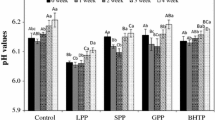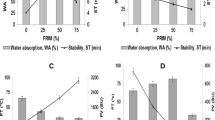3
) or ascorbic acid at levels of 50, 100 and 150 mg/kg. The effects of mixing, lipid extraction and additives on dough proteins were studied using electrophoresis. Sodium dodecyl sulfate-polyacrylamide gel electrophoresis results for the 50 % 1-propanol insoluble fractions of both varieties showed that the relative band intensities of the flours were more intense than those of the optimum mixed control doughs. KBrO3 did not affect the extractability of protein in optimum mixed dough, while ascorbic acid reduced the extractability. Generally, overmixing caused a decrease in relative band intensities. The reductions in the relative band intensities were especially noticeable in the oxidant-added doughs. The relative band intensities of the defatted samples were more intense than those of the undefatted ones.
Similar content being viewed by others
Author information
Authors and Affiliations
Additional information
Received: 7 December 1999 / Revised version: 14 February 2000
Rights and permissions
About this article
Cite this article
Demiralp, H., Çelik, S. & Köksel, H. Effects of oxidizing agents and defatting on the electrophoretic patterns of flour proteins during dough mixing. Eur Food Res Technol 211, 322–325 (2000). https://doi.org/10.1007/s002170000177
Issue Date:
DOI: https://doi.org/10.1007/s002170000177




